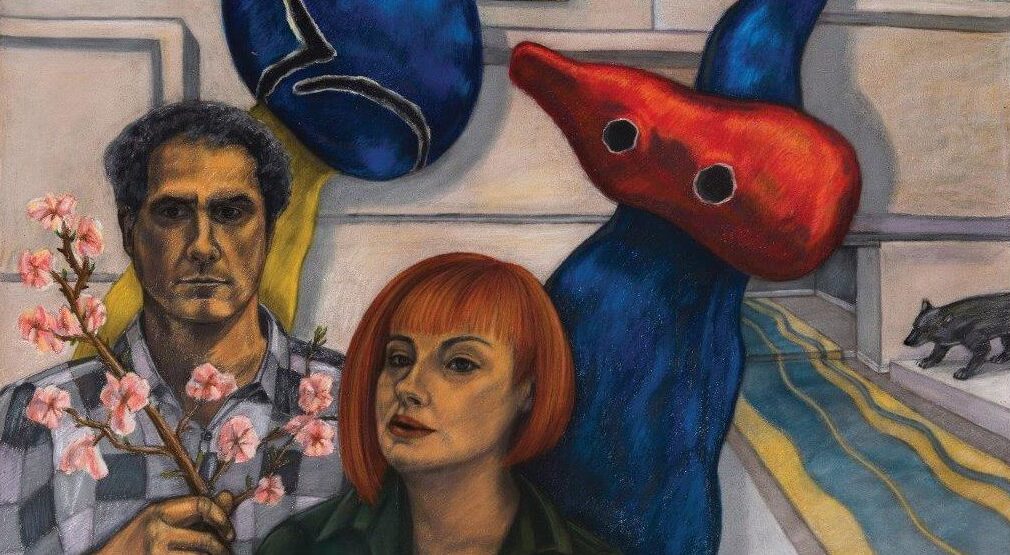
Yet, not only past artists are addressed: two of the six works – The Artist´s Wife (Paz Talpiot) and The Artist´s Wife 2 (Omanut HaMizug) – are unapologetic self-homages, alluding to Zaidel´s earlier output and adding further layers to it. (not a word to be said about the irony and mockery of classic representation of the wife inherent in choosing The Artist´s Wife as a title for the self-portraits of Zaidel, an independent artist who is also the wife of artist Oded Zaidel). Five out of six works in the exhibition feature wolves – homage to the artist´s series of wolf paintings. The wolves that she has been painting for nearly two decades represent a feral force of nature, unbridled, primeval and instinctive, which is at the artist´s disposal, protecting and serving her.
Can there exist a living dialogue with dead masters? Zaidel´s paintings prove it possible, and then some. For these are not banal gestures of adoration, quotation, or self-deprecation. The artists and their works serve as an additional palette in the artist´s archive of associations. Zaidel´s current correspondence with past masters brings them to life, which allows her to refresh her own gaze and the spectators´ gaze at the artists.
A 21st Century Femina Laudens
Zaidel approaches the dialogue fearlessly, armed with vast knowledge of art and culture, self-humor, with playfulness and… art selfie*. Surrealistically and originally, she breaks down and connects things from different fields (the artist´s paints and work materials alongside a Talpiot gas station; neo Gothic architecture with a slanted angle art selfie; abstract surrealist modeling alongside a painting of a wolf; a Dadaist Tristan Tzara mask with a Jerusalem landscape; the material world with the metaphysical world and so on…) thus connecting past works (both hers and of past masters) with the present, through objects and role playing. In this fashion, the homages become local and current. For instance:
– An art selfie of the artist and her husband, artist Oded Zaidel, set against Miro´s abstract surrealist sculpture Pair of lovers playing with almond blossoms, wherein Oded holds a real branch of almond blossoms (in the painting Homage to Juan Miro).
– A selfie of the married couple (flesh and blood family) inside Gaudí´s Sagrada Família (holy family) basilica with pigeons on their heads (in the painting Homage to Antoni Gaudí).
– The artist sleeping in her Jerusalem studio, holding Marcel Janco´s Tzara Mask, reconstructing Man Ray´s surrealist photograph Black and White (1926) in a multi-recipient homage to Tzara, Janco, Ray, Brâncuși´s sleeping Muse and Zaidel´s own wolf paintings (in the painting The Dream about Marcel Janco).
– Man Ray´s flat iron with a row of nails, turns into a modern day electric iron resting on the sleeping artist´s desk in the studio, and set against blue wolves floating above the Dome of the Rocks and a giant fish swimming in through the window, in a rich multi-recipient homage to Man Ray, Alberto Savinio, Giorgio de Chirico, and Zaidel´s series of wolves and fishes (in the painting Man Ray´s Gift).
The questions that Zaidel poses and the drawing technique:
“How are all of the past´s masterpieces and great ideas integrated into a work of art that happens at my studio at this very moment? The dialogue´s nature does not change: the cultural-artistic-conceptual dialogue in every culture, at all periods, never ends with an artist´s death, and continues to exist in all following art works.”
Past artists habitually used pastel drawings as small format sketches for the “real” painting (normally oil paintings). French artist Edgar Degas made noticeable use of pastel chalks, yet it is rare to encounter current artists who create large format dry pastel drawings as Zaidel does. Similar to writing, hatching on paper is an intimate medium that creates a complex allusion to the painted objects: instead of words, there are changing lines, life. Drawing seems like a period-less sentence in the middle of a conversation. It is a process, something that forever creates an illusion of being unfinished, not final, because even if the details within it are fully processed and whole – as they are in Zaidel´s works – one can always see the paper breathing through the hatching, in contrast with an oil painting, for instance, where the painted surfaces are blocked. Pastels are made of wax, sap (acacia gum), charcoal and chalk – natural materials that lend the drawings an effect of warmth and naturalness.
Zaidel is a Femina ludens (latin: playing woman), to paraphrase the term coined by historian and cultural theorist Johan Huizinga in his books Homo Ludens (1966)** surveying the play element in human society. Huizinga claimed that play is close in spirit to art and religion, and functions as a sort of exit from the material world. This exit does not diminish the seriousness of the game. On the contrary – it turns play into one of man´s most superior activities as a culture creator. Much like the Dadaist and Surrealist avant -garde artists to whom she alludes, Zaidel has fun playing with realistic and imaginary materials, building a world of surrealistic (from French, beyond realism) images, detached from its ordinary context and free from the constrictions of the material world´s logic, thus encouraging the spectators to overstep and expand their intellectual boundaries.
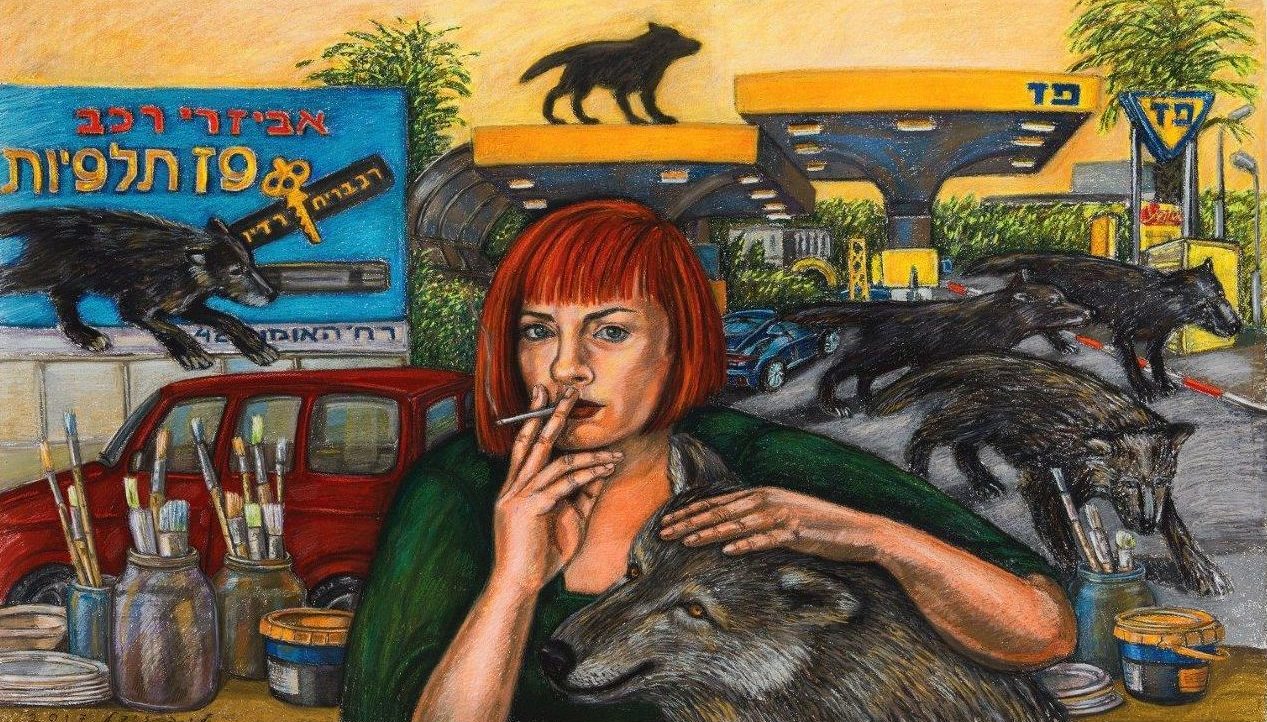
1. The Artist’s Wife (Paz Talpiot), 2017
This painting alludes to classic-idyllic representations of women by European painters (mainly from the 18th and 19th centuries) and breathes life into the over-familiar theme of ´the artist´s wife´, which began as early as the 15th century with Jan van Eyck´s portrait of Margareta, the Artist´s Wife (1439). Zaidel corresponds with the classical conception of the wife, as reflected for example in the drawings of Carl Joseph Begas (1825) Thomas Gainsborough (1758) and Jacques -Louis David (1812) by casting self-aware, defiant and humorous modern content into the concept of the wife´s representation.
In the paintings of Begas, Gainsborough and David (as well as in Paul Rubens´) the wife has no existence independent of being “the wife of”. Following the idyllic concept, the portraits depict women who are full of tenderness, modesty and grace. They possess character, personality and strength, and yet it is clear to the spectator that they do not create and are not creative. The women in these paintings obey the existing social order, rather than rebel against it. By choosing the title The Artist´s Wife for her self-portrait, Zaidel, herself an artist and artist Oded Zaidel´s wife, ridicules and pokes fun at the classical conception of a wife, reflecting the change the concept has undergone since the 17th century and creating a vivid, layered, ironic, and self-conscious dialogue with this concept.
The fierce and sensual colors in the painting are anything but submissive or faint-hearted. The artist paints herself in an unapologetic self-homage. She is at the forefront of the painting, one hand holding a cigarette and the other resting on the head of a grey wolf (the six wolves in the painting create a kind of a Russian doll of homages: the painting is a tribute to the genre of paintings of artists´ wives, inhabiting a self-homage to another of the artist´s works, Paz Talpiot, from 2006, where six grey wolves appear at the same gas station). The wolf represents a feral force of nature, unbridled, primeval and instinctive, that is at the artist´s disposal, protecting and serving her. In the background, behind Zaidel´s left shoulder, there is a royal blue Jaguar, suggesting the reclusive (jaguars spend most of their lives alone) super predator. Primeval, independent creative forces engulf the artist.
Behind the artist´s right shoulder is a sign that reads, “HaOman Street”, a real street in the rough industrial area of Talpiot neighborhood in Jerusalem. In Zaidel´s painting, the male artist´s (oman) street becomes the female artist´s street. The sign also says “Paz Talpiot” in yellow-gold color, and behind it is a Paz gas station, which is also painted in golden yellow (in Hebrew, paz means gold). The sign also has a golden key; the sky is also yellow-gold. The gas station´s gold/paz dons an additional layer of meaning, symbolizing the creative fuel of the artist, the owner of the gas station/artwork, who is also dangerous (smoking next to a gas station, radiating authority and defiance) and at the same time royal, a kind of redheaded enchantress who has all of reality´s materials at her disposal (a wolf, the creative fuel, the golden key, the artist´s tools: brushes, color boxes, and saucers for color mixing). This is a refreshing, modern, playful and original allusion to the classical representation of the woman and of the artist´s wife.
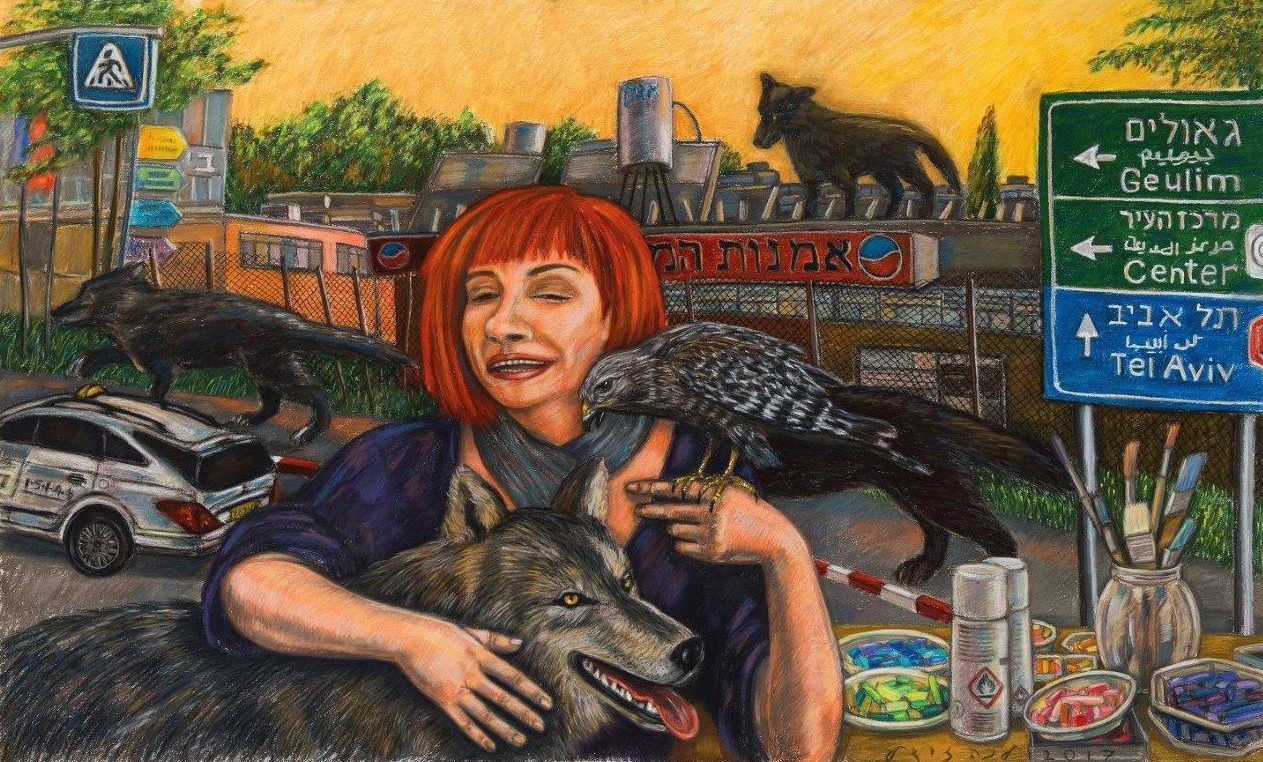
2. The Artist´s Wife 2 (Omanut HaMizug), 2017
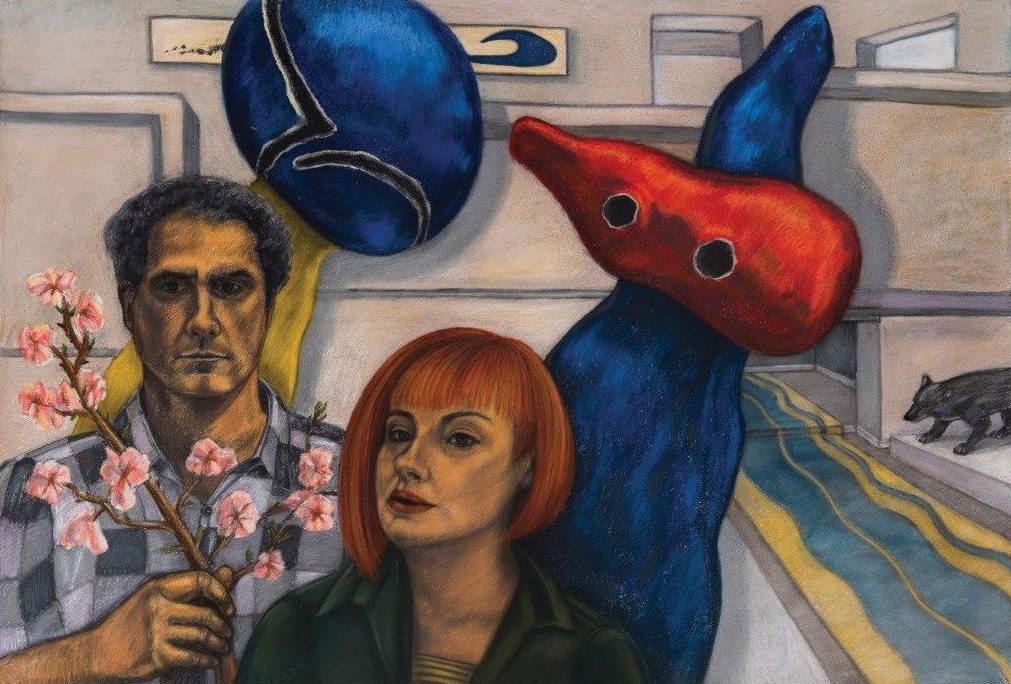
3. Homage to Joan Miro, 2018
The artist corresponds with the abstract surrealist statue of the Catalan artist Juan Miro (1893-1983) Pair of Lovers Playing with Almond Blossoms (1975) and creates a layered homage, composed of a selfie and homages: to the great artist, to her relationship with her husband, artist Oded Zaidel (the two embody Miro´s lovers in a current and self-humored realistically painted art selfie, with Oded holding a branch of almond blossoms) and a painted homage to the art selfie*, as the itself painting is based on a selfie of the artist and her husband set against the background of the model of the statue at the Juan Miro Museum in Barcelona. The frequent use Zaidel makes of the art selfie on Facebook, photographed alone or with her husband against works in hers and other artists´ exhibitions, has become her hallmark. The painting also entails a self-homage to the representation of the artist in social media.
The metaphysical dimension is not absent from this work, nor in any of the exhibition´s other paintings (and in Zaidel´s works in general). Zaidel: “I knew Miro´s famous sculpture without knowing its name. When I painted the work, I didn´t know that it was titled Pair of Lovers Playing with Almond Blossoms. I added the almond blossoms to the painting intuitively, and only after I finished the painting, I found out to my amazement that the almond blossoms were part of the title!”
The painting shows mystical elements and clues: to the left of the pair of artists, there is a long, narrow rug, which looks more like a flowing rippling river than a rug in a museum. The carpet/river separates – and at the same time bridges – two different worlds, much like the Styx or the Acheron, the underworld´s tunnels in Greek mythology. One world, the material one, of a pair of artists standing in front of a famous surreal sculpture and the second world, represented by the grey wolf on the other bank of the river (also as a reference to the artist´s series of wolf paintings and another artistic representation of herself) – a feral, liberated, primeval and instinctive force of nature, whose existence is not necessarily physical. The wolf is standing on the riverbank, perhaps meaning to cross it, or perhaps guarding and protecting his territory, a kind of private Cerberus to the artist (Cerberus: the hound dog of Greek underworld god Hades, that guards the gates of Hades). Another clue that fortifies the association of a river connecting two different worlds: Zaidel is wearing a striped sailor´s shirt and, as an artist, she is capable of sailing through her art between the material and the spiritual worlds, between facts and intuitive inner knowledge of the subconscious, such that motivates her to add a branch of almond blossoms to a painted homage to Miro´s sculpture, without knowing that the name of the statue is Pair of Lovers Playing with Almond Blossoms!
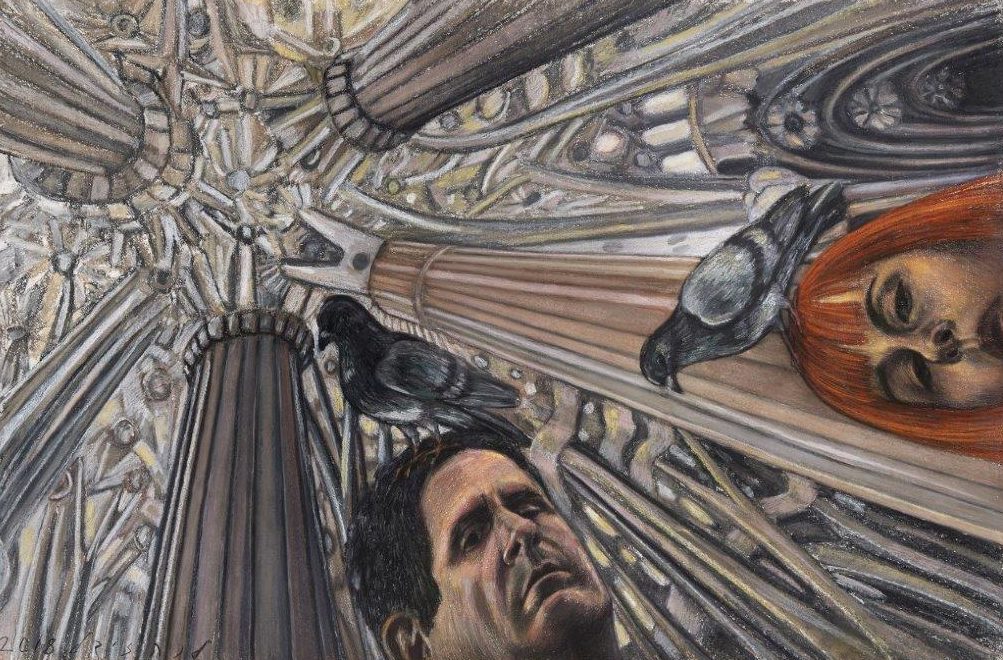
4. Homage to Antoni Gaudí
The first impression the painting creates is of a Gothic atmosphere, both because of the solemn and gloomy double portrait of the artist and her husband, and because of Gaudí´s (1852-1926) neo-Gothic architecture; even though he designed the Sagrada Família (holy family) basilica in Barcelona in the spirit of Catalan modernism, he was influenced by the architecture of Gothic cathedrals. Yet, on further observation, the initial impression of gloominess is replaced with a playful atmosphere. Zaidel creates a subtle homage that transcends a painted art selfie of herself and her husband (artist Oded Zaidel) set against the basilica´s interior, alluding to Gaudí´s grandiose complexity in a playful and self-humored fashion. The artist´s human (non-holy) family is painted within Gaudí´s Sacred Family, and similarly to the homage to Juan Miro, embodies the title of the painting in a self-aware fashion. As in the other homages in the exhibition (to Juan Miro, Marcel Janco/Tristan Tzara, Man Ray, and to herself and her prior works) the selfie is used as a means and an aid in Zaidel´s work, and is not the essence. The essence is the current living dialogue with the past and with past masters, and Zaidel´s fearless examination of the past masters´ relevance to her current work.
Usually, when discussing Gaudí´s work, the focus is on the external appearance of his magnificent buildings. Zaidel corresponds with Gaudí “from within”, from inside the Holy Family basilica (whose construction began in 1882, continued after Gaudí´s death and is expected to end in 2026). She follows the inner laws of Gaudí´s Neo-Gothic style from inside the basilica: the use of high vertical lines and the points of intersection that tapers up of the vaults and pillars, give the spectator a sense of sublimity, infinity, a yearning for the divine and the spiritual. The faces of Zaidel and her husband under the pillars, serve as an anchor to the feeling of sublimity and infinity created by the high vertical lines (a central motif in Gothic architecture). The artist and her husband, in a gloomy selfie, look like icon statuettes watching the world (and those who observe the painting) from above. Gaudí´s basilica, which I call “architecture´s Bach,” is a triumphant celebration of grandiose complexity and inquiry into the divine order, as reflected in universal aesthetic principles (symmetry, harmony, geometric laws, and the use of light).
Only that Zaidel introduces humor, playfulness and iconoclasm (from Greek, image breaking) to the gloomy and pathos-filled situation in the basilica: the selfie was taken at an angle, which creates harmony and symmetry that differ from those of Gaudí´s – more dynamic, chaotic, and playful. Changing the viewing angle turns the structure above the artist and her husband´s heads into a human parody of the divine order, creating a new order in which there is room for chaos, self-humor, and a wink that the artist aims, from inside the basilica, at those viewing the painting: on top of Zaidel´s and her husband´s heads stand pigeons, bringing to mind classic statues positioned respectfully in public squares, their heads or shoulders hosting pigeons that often… defecate on them (and on the pathos and self-importance that these sculptures radiate)! As in three other homages in the exhibition (to Juan Miro, Marcel Janco/Tristan Tzara, and Man Ray) here too Zaidel is conducting an authentic, contemporary and fresh dialogue with a great artist without diminishing her own value or blindly glorifying adored works of art.
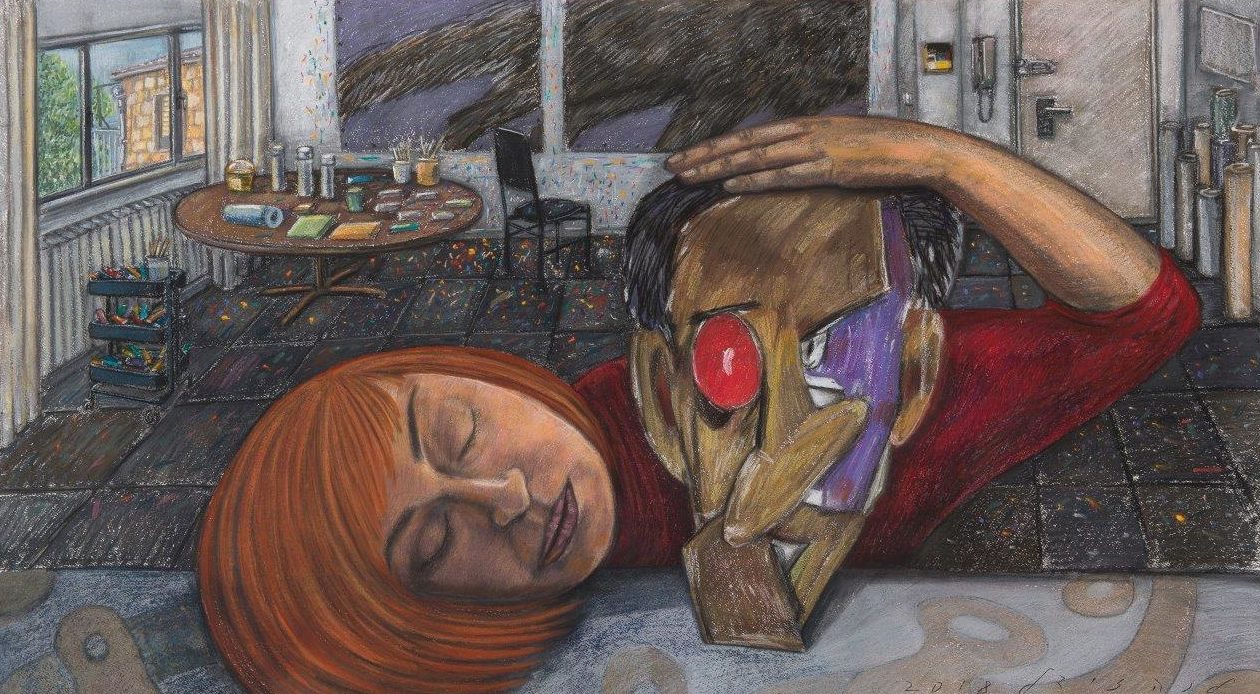
5. The Dream about Marcel Janco
This is the first of two paintings bearing the same title, that were displayed at the Marcel Janco permanent exhibition hall at the Janco Dada Museum in 2019, as an integral part of an exhibition dedicated to his work. The artist and her husband were commissioned to create tributes to Janco´s works, inspired by his works.
In the painting paying homage to Dadaist artist Marcel Janco´s (1895-1984) The Tzara Mask (1960) – which in its turn, is Janco´s homage to his friend and compatriot, poet, writer and essayist Tristan Tzara (1896-1963) one of the founders of the Dada movement (also a member of the group of French surrealists and the author of the 1918 Dada Manifesto *) – Zaidel adopts the Dadaist spirit of the absurd, the surrealist gloominess and the preoccupation with dreams and the subconscious, which were the source of artistic inspiration for the artists of Figurative Surrealism/Verism (from Latin, verum, truth. A style where the details look real/true), but their combination creates a strange and dissociated world of images, giving the work a dreamlike or hallucinatory ambience not bound by logic.
Still, as with Zaidel´s other homages, this one is layered, rich and sophisticated: it is an homage and an allusion to other works and artists (Man Ray, Constantin Brâncuşi) as well as a self-homage (the Wolf diptych in the background, referencing Zaidel´s series of wolf paintings, symbolizing a feral force of nature, unbridled, primeval and instinctive).
Zaidels is painted in round lines and warm colors (orange, maroon) asleep in her studio in Jerusalem, her head resting softly on the table, her left arm around the grumpy Tristan Tzara (cardboard) Mask by Marcel Janco, which turns from a three-dimensional cardboard mask into a two-dimensional expressive image severed from its original context, while creating a contemporary remake of Man Ray´s famous paintings, Black and White (1926). The lying head of the sleeping artist alludes also to Constantin Brâncuşi´s sculpture Sleeping Muse (1909) showing an abstract head of a lying figure. In the painting, there is a fusion of the artist and the muse, annulling the traditional male dichotomy between the artist and his muse. The tablecloth the artist sleeps on has a motif from the work of French Dadaist artist Jean Arp.
Zaidel summons the great Dada and Surrealism artists to her Jerusalem studio, to create a (literally) dreamy dialogue with them. The atmosphere of the dream is intensified by the color stains twinkling like stars on the dark studio floor, and by the use of purple (the color of the seventh chakra, responsible for intuition and foresight) in the mask, as well as in the giant wolf diptych.
According to Zaidel, the encounter between the contemporary dreaming artist and the grumpy/rebellious past master (who has become two-dimensional in her hands) in the artist´s Jerusalem studio space, “poses a question about the relevance of the gaze that is trained on the past, on the other artist: how can one connect the past with what is happening today? How do all masterpieces and great ideas of the past relate to the work that takes place at the studio right now? Surely, the essence of dialogue does not change: the cultural/artistic/conceptual dialogue (in all cultures and all times) never ends, and continues to exist in all works of art, like a layer cake, whether the artist indicates it or not.”
* In the manifesto summarizing the principles of the movement, Tzara rejects reason, morality and science, who according to him drove the world to madness. In their stead, he puts lack of reason and absurdity. In order to be free from the reign of misguided logic, Tzara proposes destruction. He stresses that it is necessary to sweep and purify the rotten and putrid world with anarchism and the negation of everything (“The true Dadaist opposes Dada”). As mentioned above, Tzara´s manifesto stands for deconstruction and destruction. (Art in a Technological Age, The Open University, 1982).
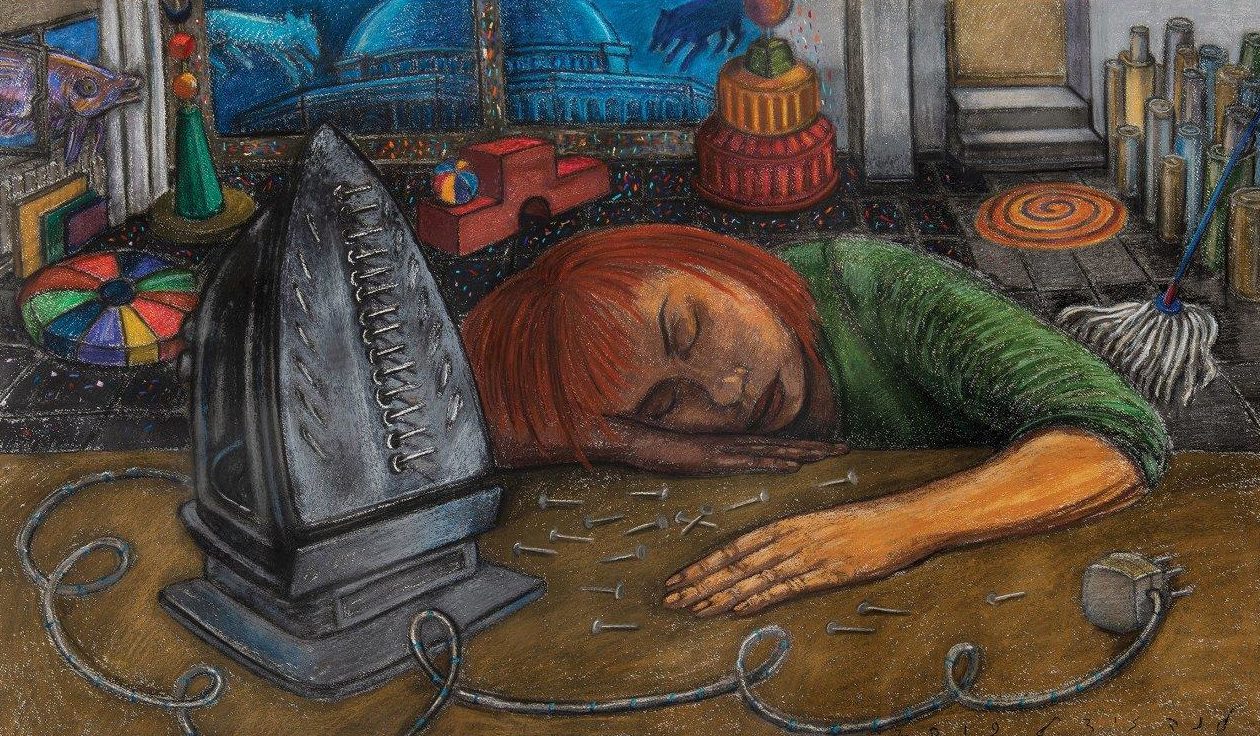
6. Man Ray´s Gift, 2019 (dry pastel on paper)
In this painting, as in The dream About Marcel Janco, we meet the sleeping (and dreaming?) artist with her head on the studio desk, posed like Brâncuşi´s Sleeping muse. The gift in Zaidel´s painting has three recipients: Man Ray, the artist and those watching it:
1. Gift (1921) is the name of the famous ready-made work by photographer and avant-garde artist Man Ray, which became one of the most well-known Dada and surrealism symbols and harbingers: a flat iron with fourteen nails glued to its bottom, in a way that turns it into an unusable and unnerving object, evoking sadistic associations. The neutralization of the usability of the iron (an object that a hundred years ago was a common wedding gift, therefore symbolized home and union) and its alteration, demonstrate the ability of surrealism to evade the laws of logic and to blur the relationship between the objects and the words depicting them (or, in the language of semiotics, symbol research and symbol systems: intentionally sabotaging the relations of signifier and signified). Therefore, the title of the piece completely contrasts the implications that Ray´s flat iron of nails evokes in the spectator.
2. This is a gift from Man Ray to Zaidel – the artist and her art – for Zaidel is conducting an updated and refreshing correspondence with Ray´s 99-years-old Dadaist/surrealist gift, by a Dadaist act of dismantling and reassembling (just as Ray alters and enriches the iron, giving it a new and not entirely deciphered role) in her latest and unique style. This is the recurring principle common to the rest of Lena´s works in this exhibition (and not only) – a connection between different times and things from different worlds and fields.
3. Zaidel´s Ray´s gift to the spectator, who has to decipher the multitude of symbols, self-homages and homages to other artists that are scattered around the painting like toys.
Zaidel connects the past and present through objects, adapting Ray´s iron to the 21st century: her iron is modern, electric, plastic base included. In addition, there are nails scattered on her desk, which hints the artist fell asleep in the middle of work (the sleeping artist, perchance dreaming of an iron, in the surrealist spirit of the painting). In this painting, too, (as in Dream about Marcel Janco, but in a more pronounced way) the intense color stains twinkling as stars on the dark floor of the studio intensify the dream atmosphere and obscure the border between the interior of the studio and the outside world. Still, the exterior is also surreal, perhaps a blue sea, perhaps the sky: through the studio window can be seen a huge fish floating/swimming into it – a self-homage to Zaidel´s Monastery Roof and King George St. (from the series Broken Hearted City Center, 2009) in which huge fish swim over people´s heads above the Dome of the Rock and over the Jerusalem Street in a post-apocalyptic atmosphere, as if Armageddon is upon us, and Jerusalem is already under the sea.
On the studio wall, behind the sleeping artist, there is a diptych of a mosque with two wolves hurtling toward it with blue night sky in the background – a self-homage to Dome of the Rock 5, (from the series Broken Hearted City Center I & II, 2008-2010). Including the Dome of the Rock, at the top of Temple Mount, one of Jerusalem´s most charged symbols, makes Zaidel´s homage local, contemporary, and unadorned.
Just as Zaidel links the past and the present through the objects (the flat iron opposed to the electric iron), so she binds the art of the past (early 20th century avant-garde) to her here-and-now anchor (Jerusalem, a self-homage to her paintings in the 21st century).
Scattered all around the studio are colorful and somewhat fantastic objects that look like big, intriguing toys: these are homages to the works of author and surreal artist Alberto Savinio (born Andrea Francesco Alberto de Chirico, 1891-1952) – especially the oblate circle of colors and the colorful game ball – and of his brother, the pre-surreal artist Giorgio de Chirico (1888-1978): three structures made from geometric shapes (cubes, cones and spheres). At the top of the pointed tower (next to the fish) reminiscent of a minaret, is a crescent, usually a symbol of the Islamic faith. To its right, a round layer cake-like structure, with a sphere/sun at its top; it somehow looks like a toy shrine. Both buildings, at the background of the Dome of the Rock, conduct a playful dialogue between them and with one of the symbols of the Al-Aqsa Mosque. This is another example of the sophisticated way in which Zaidel fuses various worlds, periods and objects, thus creating an original homage, full of humor and depth, alluding to both past and present.
On the floor, next to the studio´s front door, there is a round orange mat, on which a spiral is drawn – an ancient symbol since prehistoric times, an open and infinite form repeating itself but constantly changing, just like the artistic-conceptual dialogue (in all cultures and all times) which never ends and continues to exist in all works of art.

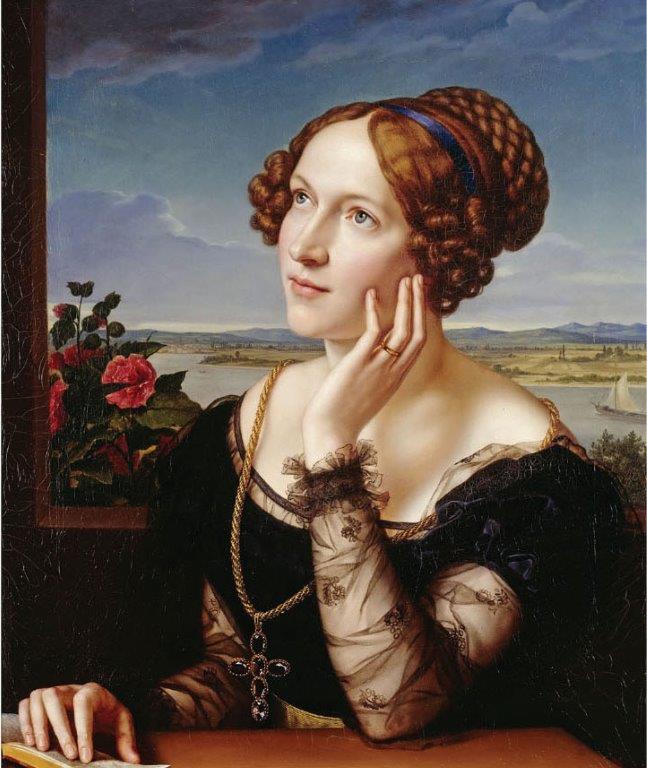

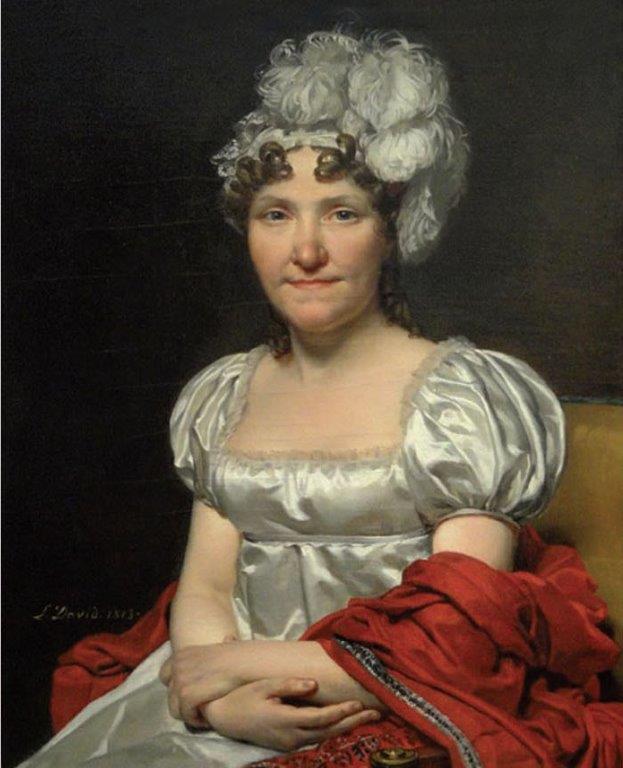

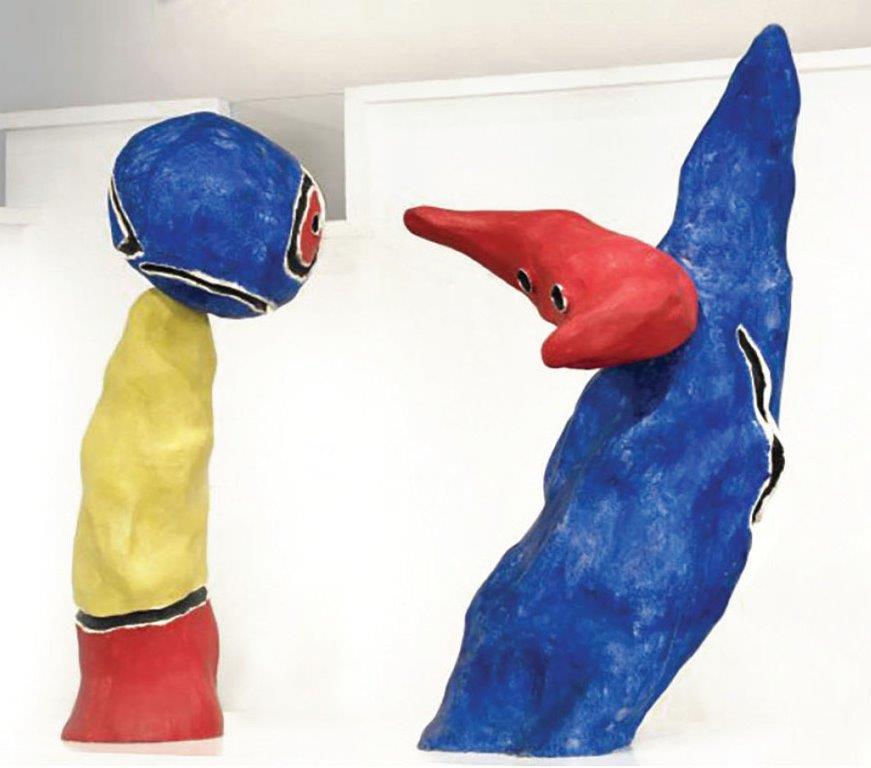

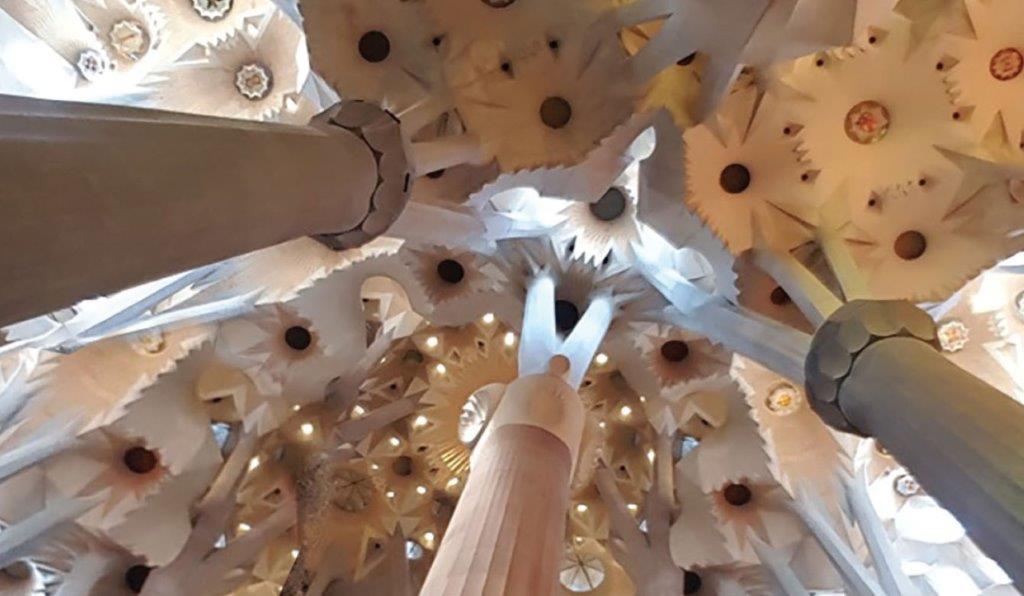

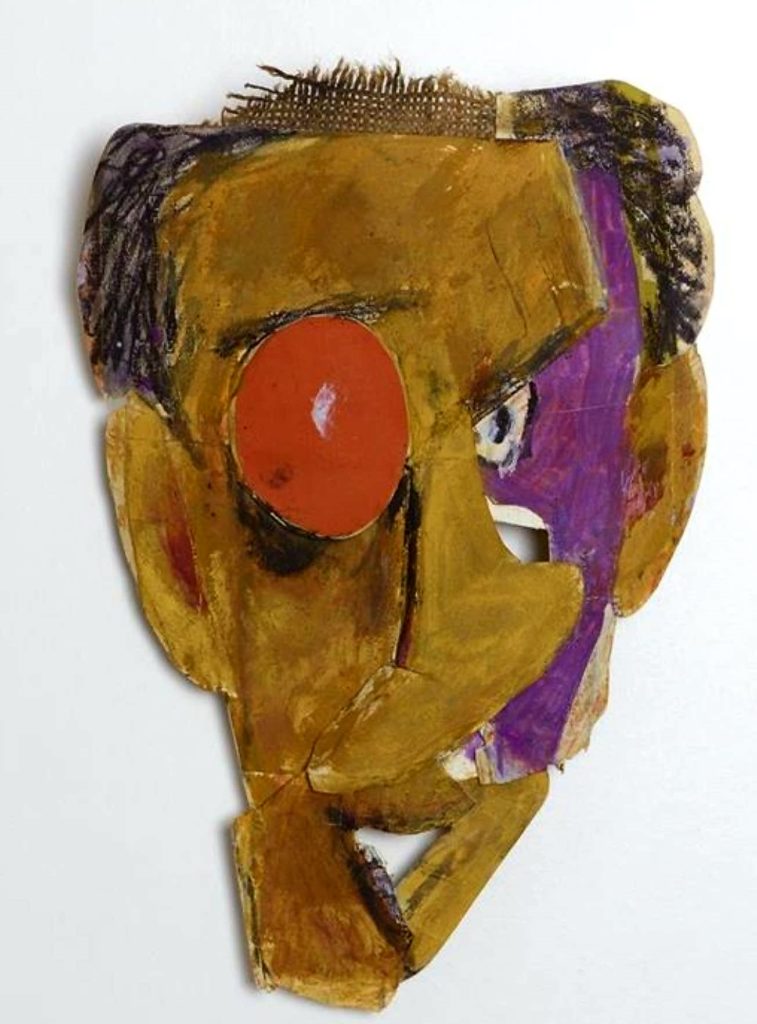

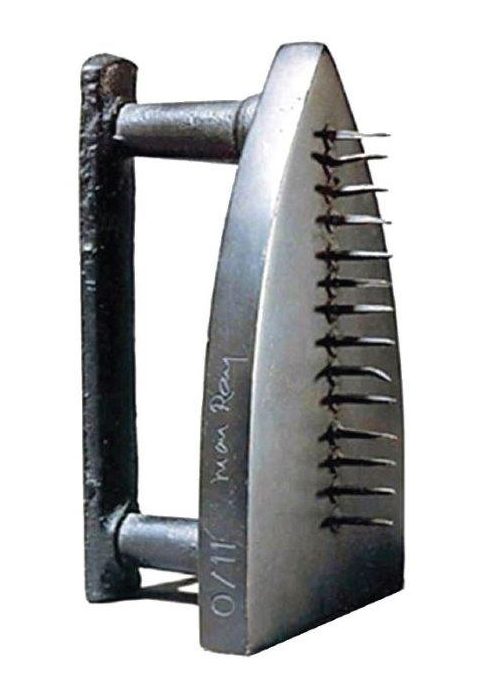
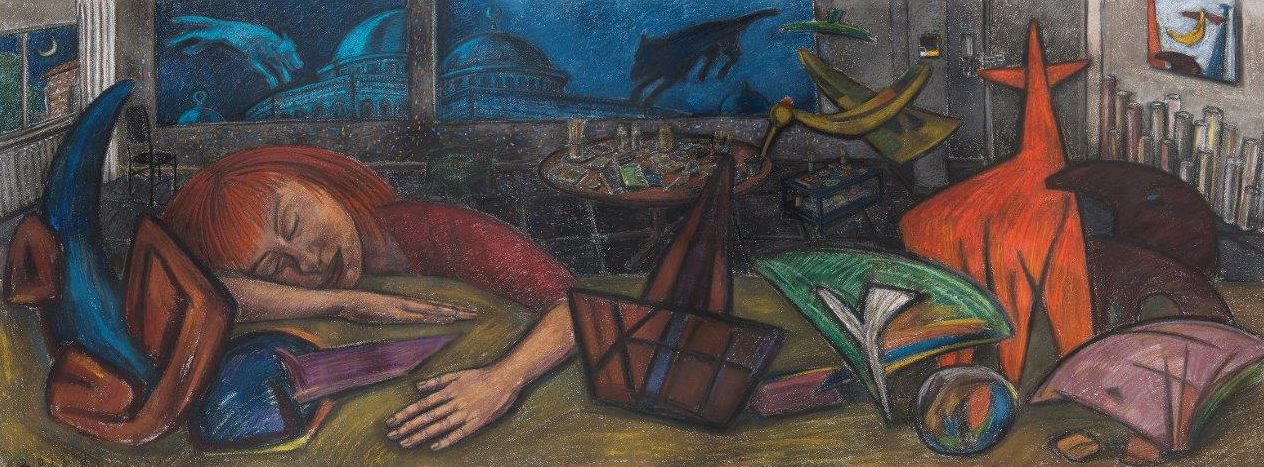

The Jrusalem Post, “Art for all ages – and places,” by Barry Davis (about “Homage” by Lena Zaidel)
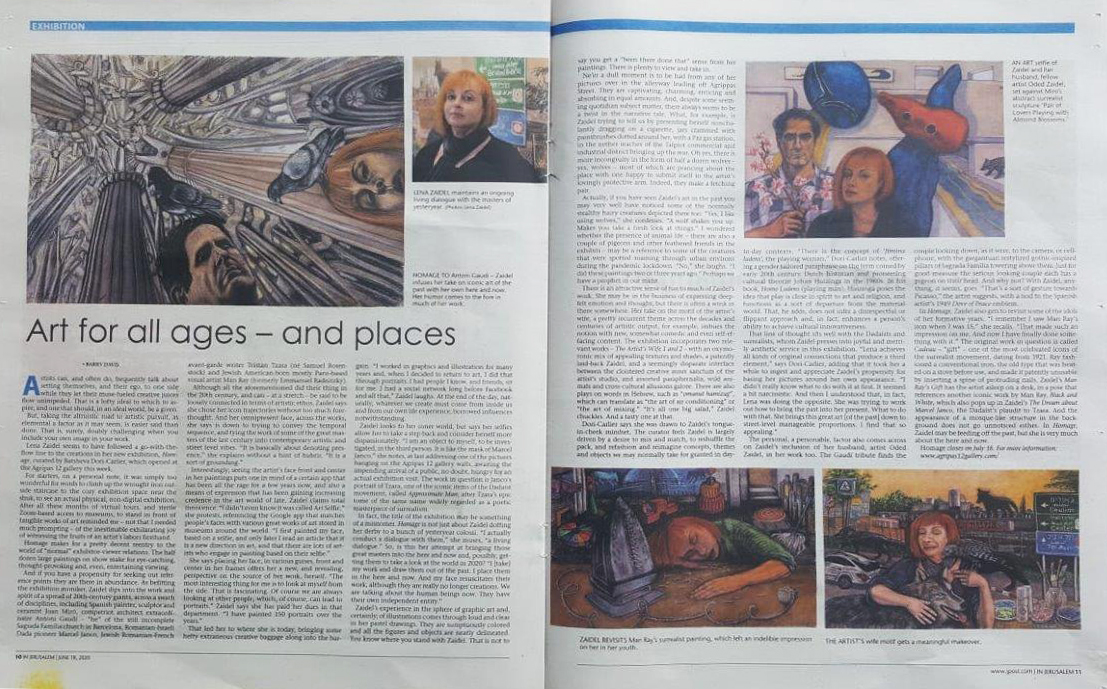
Show More